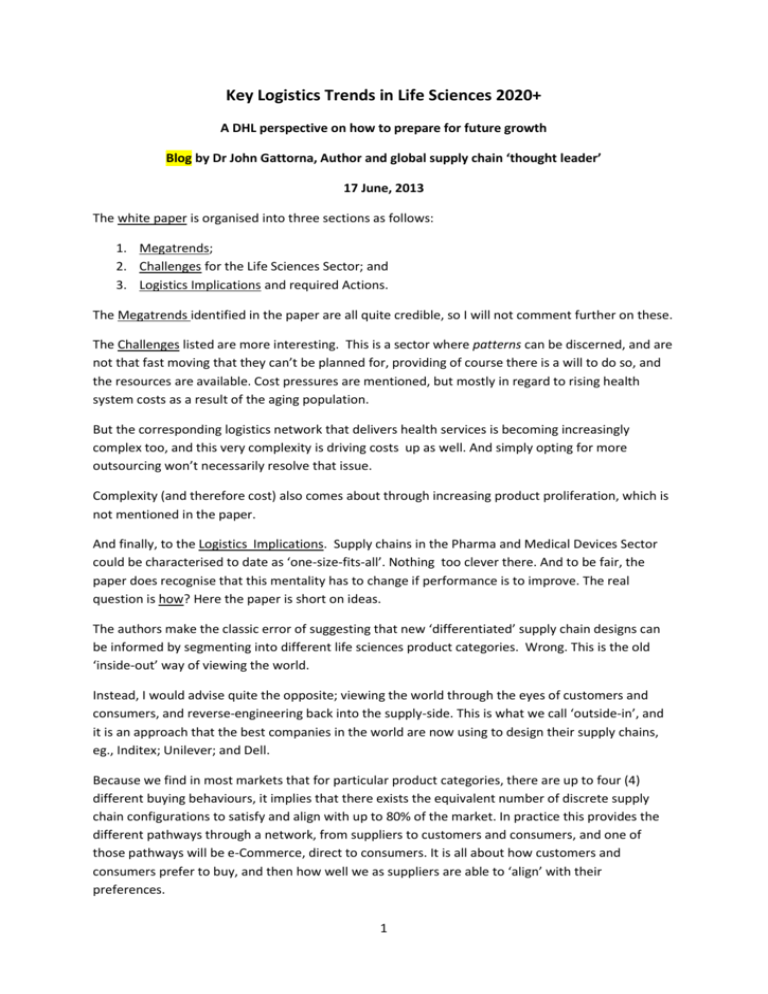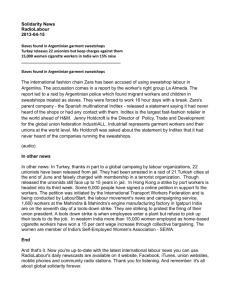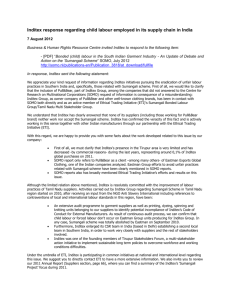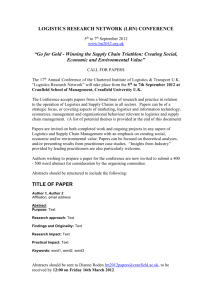Key Logistics Trends in Life Sciences 2020
advertisement

Key Logistics Trends in Life Sciences 2020+ A DHL perspective on how to prepare for future growth Blog by Dr John Gattorna, Author and global supply chain ‘thought leader’ 17 June, 2013 The white paper is organised into three sections as follows: 1. Megatrends; 2. Challenges for the Life Sciences Sector; and 3. Logistics Implications and required Actions. The Megatrends identified in the paper are all quite credible, so I will not comment further on these. The Challenges listed are more interesting. This is a sector where patterns can be discerned, and are not that fast moving that they can’t be planned for, providing of course there is a will to do so, and the resources are available. Cost pressures are mentioned, but mostly in regard to rising health system costs as a result of the aging population. But the corresponding logistics network that delivers health services is becoming increasingly complex too, and this very complexity is driving costs up as well. And simply opting for more outsourcing won’t necessarily resolve that issue. Complexity (and therefore cost) also comes about through increasing product proliferation, which is not mentioned in the paper. And finally, to the Logistics Implications. Supply chains in the Pharma and Medical Devices Sector could be characterised to date as ‘one-size-fits-all’. Nothing too clever there. And to be fair, the paper does recognise that this mentality has to change if performance is to improve. The real question is how? Here the paper is short on ideas. The authors make the classic error of suggesting that new ‘differentiated’ supply chain designs can be informed by segmenting into different life sciences product categories. Wrong. This is the old ‘inside-out’ way of viewing the world. Instead, I would advise quite the opposite; viewing the world through the eyes of customers and consumers, and reverse-engineering back into the supply-side. This is what we call ‘outside-in’, and it is an approach that the best companies in the world are now using to design their supply chains, eg., Inditex; Unilever; and Dell. Because we find in most markets that for particular product categories, there are up to four (4) different buying behaviours, it implies that there exists the equivalent number of discrete supply chain configurations to satisfy and align with up to 80% of the market. In practice this provides the different pathways through a network, from suppliers to customers and consumers, and one of those pathways will be e-Commerce, direct to consumers. It is all about how customers and consumers prefer to buy, and then how well we as suppliers are able to ‘align’ with their preferences. 1 If we adopt this approach, answers to questions about how we should configure our e-Channel; and how we should ‘adapt’ to rapid changes in demand patterns; become relatively easy to answer- we simply set up separate supply chain configurations, hard-wired into the business, to deliver the appropriate service propositions, no more, no less! Finally, the question of supply chain visibility. There is no question that this is a big issue for all parties along contemporary supply chains. But here again, easy to say; not so easy to do. Inditex (owner of the Zara brand) have found a simple solution. Every garment [of the 200 mil. ] that comes from a supplier must have a particular device clipped to it. This device, specified by Inditex and made by Tyco, acts as both a security device, and with an embedded RFID chip, also allows Inditex to track each garment from supplier, through their own internal sorting system, to the shop floor, and is only removed at the point-of-sale. That’s visibility, delivered. The devices are low cost and reusable. Simple but effective. As an overall comment, the paper starts well and has interesting observations to make at the macro level. But this industry-sector is now so far behind the fmcg, electronic hi-tech, and fast-fashion sectors, it should be seeking to learn from experiences there, and leap-frog to a new level of supply chain sophistication. The alternative is to just follow-your nose and improve incrementally by focusing on what goes on inside the Sector. The right right choice is obvious to anyone outside the sector. **** 694 words 2











